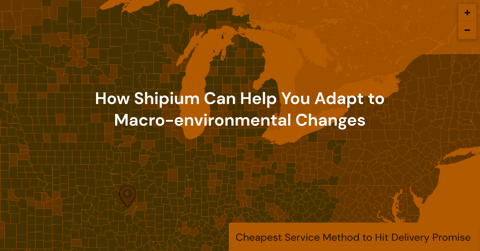How Shipium Helps You Adapt to Macro-Environmental Changes

Last Thursday, Pitney Bowes announced that its ecommerce logistics unit will be shutting down, which means that shippers who rely on its parcel delivery services will need to make major operational adjustments in the coming weeks.
News of this shutdown, like the changes to USPS partner deals just months before it, provides yet another example of why it's important for shippers to build flexible, resilient networks that can quickly adapt in the face of unexpected changes.
In this post, we'll explore the challenges that Pitney Bowes' shutdown will cause for shippers, and how leveraging a modern parcel management system like Shipium can help you adapt to large-scale unexpected changes faster and more effectively.
Impact to shippers
Like many macro-environmental network changes, this shutdown presents both operational and financial challenges for shippers. If those challenges aren't addressed properly, they'll also negatively impact the customer experience.
Major process disruptions
Shippers relying on Pitney Bowes for a significant portion of their parcel shipments have just weeks to adapt their strategies and divert volume to other carriers. This is a complicated, labor-intensive task that will be that much more challenging for shippers who need to establish new carrier contracts to complete it. Negotiating contract terms, integrating with new carrier systems, training employees on how to use them, and developing new fulfillment plans all take time.
Increased shipping costs
Even before news of the shutdown, Pitney Bowes had increased rates for shippers across the board. Now, shippers entering contract negotiations with new carriers have very limited leverage to negotiate favorable rates, considering the time constraint they're facing.
In addition to this, shippers will likely need to use premium service methods expedite a large volume of shipments to prevent or limit delays.
Customer experience impact
In the short-term, shipping delays can negatively impact customer satisfaction and brand perception. In the longer-term, shippers who are unable to adapt and address rising costs may need to pass those increases on to customers, which further damages perception and makes it more likely that those customers will buy from competitors instead.
How Shipium can help
Enterprise shippers using Shipium have built-in functionality that can help to implement a new carrier (or establish a multi-carrier strategy), run predictive scenario analysis to determine the right adaptations to make, and execute changes without needing to train operators on individual carrier systems.
Contract virtualization and rapid carrier setup
If these changes require you to renegotiate contracts with a carrier, or even add a new carrier to better support the volume moving throughout your network, Shipium eliminates the IT burden associated with changing contract details within your software systems.
Carrier contracts can be directly uploaded and fully virtualized — once set up, our Dynamic Time-in-Transit modeling will account for changes to rates and service methods when recommending an order fulfillment plan. Once updated contracts and (if needed) adjusted business rules are in place, you can automate decisions related to network changes that need to be made.
Automated, data-driven decisions
Shippers who want to immediately shift all volume away from Pitney Bowes can rely on Shipium to select the next most cost-effective carrier that can fulfill existing shipments with minimal or no delays.
As mentioned above, all contract details are virtualized in the platform — and if you’ve customized your business rules to always optimize for cost, Shipium will recommend specific downgrades that can be made to optimize costs while meeting your desired EDDs.
Scenario planning
Shipium’s Simulation tool can also be used for more hands-on control of process changes. You can use it to run complex scenario analysis to see how cost structures and shipping performance changes when you add carriers, move volume between them, try different shipping lanes, or shift inventory allocation. Shipium simulations can be completed in hours, and account for unique network properties, carrier performance data generated by millions of anonymized shipments, and macro-conditions (ex. excluding Pitney Bowes).
Wrapping up
The Pitney Bowes shutdown will introduce complexities and potential disruptions for shippers dependent on its last-mile delivery services.
By virtualizing carrier contracts, automating key fulfillment and transportation decisions, and providing ML-based tools for advanced scenario analysis, Shipium helps you seamlessly adapt to unexpected, large-scale network changes. This allows you to maintain service reliability and cost efficiency, ensuring your operations can continue to deliver on customer expectations without breaking the bank.
If creating more adaptable, scalable processes is a priority for your shipping ops team, feel free to book some time with our team to see if Shipium can help.
.png)
Read Anurag Allena's Shipium blogs. Anurag is a Senior Product Marketing Lead at Shipium and an experienced software marketing professional.


